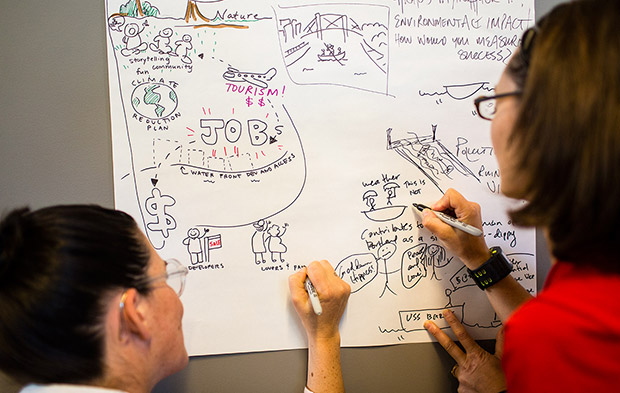What is Service Design anyway?
My favorite definition comes from Live Work, a creative agency in the UK that has really furthered the evolution of Service Design as a discipline1.
“Service Design is the design of intangible experiences that reach people through many different touchpoints, and that happen over time.” – Live Work
Service Design is not new. It draws upon all the various design disciplines; graphic, industrial, information, and heavily from interaction.
What is new is that the focus on the intangible experience means that designers must work in new ways to collaborate with organizations. It marries human-centered design with the operational and process capabilities of organizations.

Why should you care?
Our world has changed significantly in the last decade. In the digitized landscape, it’s becoming harder and harder to distinguish between products and services. The original iPod and the iTunes service platform are classic examples of how products/services being integrated.
There is business opportunity. 80% of the U.S. GDP is services and poised to grow2. What’s required to win in this market is a systems view of functionality and an understanding of how that rolls up into what customers or “users” experience emotionally as they interact with your service/product/brand.
There is also social opportunity. Co-creation is at the heart of Service Design. Services are produced in the moment of consumption. Meaning that the “customer” or user is taking an active role in creating the experience they are having. Think of what this could mean for healthcare! What if we could actually influence the system so that the patient takes an active role in creating their experience? Game-changing!
How do you do it?
A few foundational tools help frame the emotional understanding and the process understanding. Storyboards and personas help capture the context, the “how”, and the “why” of a user’s needs and desires. Service Design blueprints and journey maps capture the “what.” Blueprints are visual representations of each step or each function that happens ‘behind the curtain’ invisible to customers, but required for the organization to offer the service.
More than meets the eye
There is so much more to Service Design that a one-page summary does not begin to do it justice. There are many practitioners and researchers doing important work in this field and it is thanks to their work that Service Design is emerging and finding a much wider audience.
Service Design Resource Links:
http://www.servicedesigntools.org/
http://thisisservicedesignthinking.com/
http://files.thisisservicedesignthinking.com/tisdt_cujoca.pdf
http://www.slideshare.net/MarcStickdorn1/presentation-stickdorn-englishfall2012web
http://www.slideshare.net/jaminhegeman/5-things-i-wish-i-knew-a-service-design-journey
Bottom line
Service Design is all about execution. It’s about the organizational discipline required to deliver excellent experiences. It is not one and done. Undertaking Service Design engagements meaningfully builds organizational muscles for resiliency and graceful execution.
1“The Changing Nature of Service & Experience Design – LiveWork.” Livework. N.p.
2“Office of the United States Trade Representative.” www.ustr.gov/trade-topics/services-investment/services. N.p.
